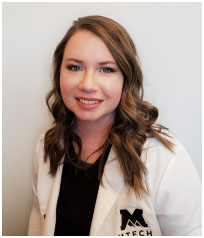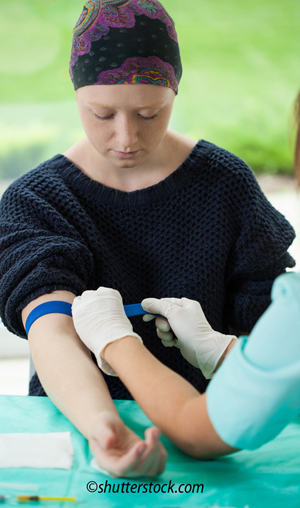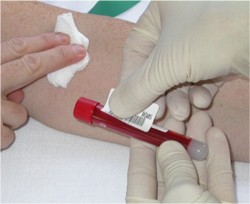Integrity in a Mistake
Own your mistakes and you own your future
by Shan Keith • May 27, 2021
Friends,
If you don't know Shanise Keith, it's about time you do. Shan teaches phlebotomy at Mountainland Technical College in Utah County, Utah. She's a fresh, passionate new voice in our industry and I have a feeling you'll be hearing more from and about her in the future as she joins our voices advocating for quality patient care through quality phlebotomy. Recently, Shan sent me an essay that really resonated with me, and I think it will you, too. This is her second article for Phlebotomy Today, and another gem.
Take care, my friend, and enjoy.
Dennis
--------------------------------------------------------

Imagine this scenario.
It’s 1 am, and it’s busy. It’s one of those shifts where you have a to-do list a mile long, and it just keeps getting longer every second. You haven’t stopped running from the moment you clocked in. Everyone is stressed, tempers are short, and you are exhausted with several hours still to go before you can clock out.
You get a call from the emergency department. They have a patient who has come in for outpatient labs sitting in the lobby. Generally, if a patient needs blood drawn after the lab has closed, the ED collects it for them. Tonight, however, their department is also slammed and has no room available for this patient who just needs a quick blood draw. They want you to go draw her blood in the lobby so she can go home. They inform you that she only needs a “rainbow” and should be an easy stick.
You find it a little difficult to believe that they don’t have even one person to spare for a few minutes to collect this patient’s blood, but you won’t tell them that. Why on earth is someone here for outpatient labs in the middle of the night? you wonder. Can’t they wait until tomorrow and come in during regular hours?
You accept their request. You know an ER lobby is the wrong place to draw a patient, but you're new and the lab's outpatient area is closed. It is not an ideal situation, but you would rather draw her blood now than make her wait a few hours before the ED can make space for her. You grab your tray and head down to the emergency room. When you reach the emergency department, you wander through complete chaos. There is at least one code blue going on. A gang of unsupervised children is wandering the halls. A homeless man who has no shoes on is having a conversation with himself. You can hear angry yelling coming from an unknown room, and you can see apparent desperation in the eyes of the ED staff as they dart around people in their way.
You eventually find the charge nurse at the nursing station, who hands you the lab order and says that the patient is still out in the lobby. You look down at the name on the lab order, and it says Sarah Wright, 27-year-old female (not her real info). You look at the labs on the order and confirm that a rainbow should indeed be more than sufficient to collect them, and you decide that you don’t need to look up the labs, as you are fairly familiar with their requirements. You quickly exit the stressful atmosphere of the emergency department and walk out to the lobby only to find that it is packed full and just as chaotic as the area you just left.
Not a single chair is empty. People are standing around the room, and some people have taken up residence sitting or lying on the floor. One man is vomiting noisily into a garbage can near the center of the room; people around him are leaning away in disgust. You see a young boy in his pajamas cradling a broken arm against his chest, with tears streaming down his face. An older woman is yelling at the receptionist about how long they have been waiting. The amount of sick and injured people waiting to be seen is overwhelming.

You take a breath and call out the name of the patient, “Sarah?” No one responds. You scan the room, looking for recognition in the eyes of the people near you. “Sarah Wright?” you call again louder. This time when you look around, you see a woman looking back at you with her hand raised.
“Did you call Sarah Wright?” she asked.
“Yes, is that you?” you respond to her hopefully.
“Yes, that is me,” she said. “I just need my blood drawn.”
Relieved you have found the correct person, you walk over to her. “Can you please tell me your birthday?” She responds with accurate information. “Great, thank you! I am a phlebotomist, and they called me to draw your blood since they are too busy here to collect it right now.”
Sarah nodded. “They said it might be a few hours before they would have time for me. I didn’t mind waiting, but I am glad you are here. I hate taking up a chair when other people could use it more than me.”
You nod, “This should just take a couple of minutes, and then you can go. Do you have a preferred arm you would like me to use?”
“Nope,” Sarah says, taking off her jacket. “I am a pretty easy stick. Choose wherever you would like.” You can barely hear her over the amount of noise from the people around you.
She holds out her arms, and to your relief, you can see she has excellent veins, though she also has clear scarring in her antecubital area. It appears she has been stuck there many times. You assume that the scars are probably from plasma donation but decide not to ask her about it in a room where privacy is not available. You apply the tourniquet and select the median cubital vein on her right arm. You will avoid the scar tissue by sticking just distally to the area.
Now that your site has been chosen, you begin to prep your supplies. There is no room to set anything, so you settle for placing your tray on the floor next to you. You take out the four tubes you will need and ask if you can put them on the chair next to her right leg. You kneel on the ground next to her, trying to find the best way to perform this draw in such an uncomfortable setting.
You put on your gloves, clean the area on her arm thoroughly, and then tie the tourniquet. You insert the needle and begin applying your tubes. Suddenly someone near you loudly asks, “Do you have to do that right here? I can’t stand the sight of blood.”
You glance over at him. He is looking at you with annoyance and anger on his face. “I’m sorry, sir, I am almost done. If it bothers you, then please look away.” You realize that you are sweating, and your anxiety rises as you hear muttered comments from the man to the people around him.

“Ugh, that is disgusting,” someone else says from your other side. You avoid looking at them and try to shake off the nervousness you are feeling.
“Sorry,” Sarah quietly says to you as you apply the last tube. “I don’t mean to make people uncomfortable.”
“You don’t need to apologize, but I appreciate that,” you say as you release the tourniquet, grateful that the draw is over and soon you will be able to return to the safety of your department. You have her hold the gauze square on her arm as you invert the three blood tubes and apply the labels. You show her the labels after putting them on the tubes and ask her to confirm that the information is correct one more time. She nods, “Yep, that all looks right.”
“Perfect, I will send these off, and you are good to go,” you say as you check her arm for bleeding and apply a bandaid.
Sarah stands up, and as she does so, you see a lonely red-top tube roll to the middle of the now vacant chair. You stare at it in confusion and then look down at the three tubes in your hand. You feel a jolt of surprise through your body. I missed one, you realize, wondering how on earth you didn’t notice you hadn’t filled up the red tube.
Sarah turns to see what you are staring at and sees the red tube sitting in the chair. “Uh oh, do you need to poke me again?”
Your mind races. You do not want to have to draw her blood again in this environment. You want to tell her that you didn’t need the red tube and that she can just go home, but you are pretty sure she does need it. Excuses flood your brain. What is the big deal, though? They will just call her tomorrow and ask her to come in and get that last tube drawn. I won’t have to deal with it, and I won’t have to draw her blood out here in front of these angry people. It might even be better that way.
NO, you decide, shaking off the temptation to let her leave. I am better than that, and I need to finish this the correct way.
“I am so sorry,” you say. “I didn’t see that tube. Let me go double-check and see if it is absolutely required or if the lab can make do without it.” You grab the tube from the chair and hold it with the other tubes as you walk back to the ER to find a free computer.
You look up her labs and see that the red tube is definitely necessary, as she has two separate tests that must be collected from plain red serum only. Inwardly you groan and get up to go collect this final tube. You walk back out to where Sarah is again sitting in the same chair. “I am so sorry, Sarah, I will need to draw your blood again. You do need that red tube.”
“That is totally fine,” says Sarah. “I don’t mind at all.”
At least she is a really nice person, you think to yourself. This could have been way worse if she was a tough stick or if she was mean. You prepare everything the same way that you had before, ignoring the loud comment from the same guy as before, “You have to do it again? Really?”
You are using her other arm this time, which has equally good veins. You insert the needle and watch with satisfaction as the tube quickly fills up with blood.

“I’m so glad you double-checked on this for me.” Sarah said. “I have a trip scheduled for tomorrow, and my doctor wanted me to get these tests done before I went.” She paused. “My cancer came back, and this is a bucket list trip that I have always wanted to take. I decided now was the time before I came back to start chemo. I had my blood drawn yesterday to clear me for the trip, but some labs needed to be redone before I left. That’s why I am here so late tonight.”
You stare at her in shock. Sarah is watching the red tube as it finishes filling with blood.
“If you hadn’t noticed that tube, my doctor probably wouldn’t have cleared me to go on my trip. It is likely to be the only trip I take, at least for a really long time.”
A lump forms in your throat as the gravity of her situation becomes fully clear to you. Sadness and understanding wash over you as you realize what you had almost cost this patient. You are unsure of what to say.
“I… am so sorry,” you say quietly and then remove the tourniquet. “Where are you going?”
Sarah’s face changes from weariness to excitement as she begins to tell you about all of the places she is supposed to go over the next few weeks. She says she is going to Europe and traveling all over the country. You listen enthralled for the next 15 minutes as she tells you about her plans with her husband and everything she is going to do on this vacation. Everyone around her is listening to her talk. The stress and the rushed chaos that was so soul-crushing before becomes nothing in comparison to the story of this young woman. You know you are running behind, but you stay and listen to her anyway.
She finishes telling you about her plans, and you thank her for sharing that with you. She gets up, smiles at you, and walks out. You turn to leave the waiting area and look at the tubes in your hand. Her blood is now so much more important than it was before. It is precious cargo. You decide to walk the blood to the lab instead of sending it through the tube system, determined to see that it gets there safely.

So what can we learn from this story?
- Everyone Makes Mistakes---Mistakes are human. Mistakes are a part of having any job. Unfortunately, as healthcare workers, our mistakes tend to have a more significant impact than they would in most other fields. That is why handling a mistake properly is so incredibly important.
- Admit Your Mistake-----When a mistake is made, do not try to hide it. Bring it to attention, and deal with it. This shows maturity and a willingness to learn from it. Make sure that, if necessary, a supervisor is made aware of your mistake. It is better if they learn about the mistake from you. This will prevent them from receiving an unexpected phone call or complaint from a patient. Instead, they will be prepared to deal with the situation.
- Apologize---Typically when a patient knows that a mistake is made, they react much better to it when they receive a sincere apology. In an article that examined the effects of apologies and medical errors, almost all patients (98%), expressed that they would prefer their physician apologized or acknowledged the error. (1)
- Fix it---What are you going to do to make it better? Find a good solution that will help the patient and yourself. This may mean stepping away and letting another team member jump in to help. Determine what will be best for the patient, even if it means that it is more uncomfortable for you to have to deal with.
- Learn From It---Why did this happen? What can be done to prevent it from happening again? Though mistakes can be painful to remember, they are also critical because they teach us how to be better.. Having a conversation with your supervisor about the incident and letting them know what happened and how you will prevent it from happening again is one of the most important things that you can do to show who you are as a person and that this mistake does not represent you.
The story I shared about Sarah actually happened to me pretty early on in my career as a phlebotomist. It shook me to my core. I have never forgotten it, and I reflect on it frequently because of the importance of the lesson I learned from it. Sure, the ER lobby wasn't the best place to draw a patient, and I should have found a more private location. But being new, my compassion for the patient dominated.
We never know what type of impact we have on our patients. Everyone is dealing with their own struggles and challenges. A small mistake to us can be devastating to the patient that has to deal with the repercussions. I am grateful to this day that I made the right decision and drew her blood twice that night. I hope she went on her vacation and had a wonderful time.
Reference:
Robbennolt, J. (2009, February). Apologies and Medical Error. Retrieved May 03, 2021, from https://www.ncbi.nlm.nih.gov/pmc/articles/PMC2628492/
Want to receive each post by email? Subscribe here!
Related Posts and Information
overall rating: my rating: log in to rate
apologize ER integrity mistake outpatient YouTube
